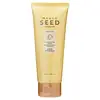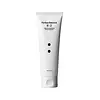What's inside
What's inside
 Key Ingredients
Key Ingredients

 Benefits
Benefits

 Concerns
Concerns

 Ingredients Side-by-side
Ingredients Side-by-side

Water
Skin ConditioningStearic Acid
CleansingPEG-8
HumectantGlycerin
HumectantMyristic Acid
CleansingLauric Acid
CleansingPotassium Hydroxide
BufferingButylene Glycol
HumectantAlcohol Denat.
AntimicrobialPEG-7 Glyceryl Cocoate
EmulsifyingGlyceryl Stearate
EmollientPEG-100 Stearate
Mangifera Indica Seed Butter
Skin ConditioningMangifera Indica Seed Oil
EmollientMangifera Indica Fruit Extract
Skin ConditioningButyrospermum Parkii Butter
Skin ConditioningCeramide NP
Skin ConditioningPhytosphingosine
Skin ConditioningPolyquaternium-7
Disodium EDTA
1,2-Hexanediol
Skin ConditioningCI 19140
Cosmetic ColorantParfum
MaskingLimonene
PerfumingHexyl Cinnamal
PerfumingLinalool
PerfumingWater, Stearic Acid, PEG-8, Glycerin, Myristic Acid, Lauric Acid, Potassium Hydroxide, Butylene Glycol, Alcohol Denat., PEG-7 Glyceryl Cocoate, Glyceryl Stearate, PEG-100 Stearate, Mangifera Indica Seed Butter, Mangifera Indica Seed Oil, Mangifera Indica Fruit Extract, Butyrospermum Parkii Butter, Ceramide NP, Phytosphingosine, Polyquaternium-7, Disodium EDTA, 1,2-Hexanediol, CI 19140, Parfum, Limonene, Hexyl Cinnamal, Linalool
Water
Skin ConditioningGlycerin
HumectantSodium Cocoyl Glycinate
CleansingSodium Lauroyl Glutamate
1,2-Hexanediol
Skin ConditioningBetaine
HumectantHydroxypropyl Starch Phosphate
Camellia Sinensis Leaf Extract
AntimicrobialMelia Azadirachta Leaf Extract
Skin ConditioningLaminaria Japonica Extract
Skin ProtectingMelia Azadirachta Flower Extract
Skin ConditioningEclipta Prostrata Leaf Extract
Skin ConditioningUlmus Davidiana Root Extract
Skin ConditioningFicus Carica Fruit Extract
HumectantCentella Asiatica Extract
CleansingAmaranthus Caudatus Seed Extract
Skin ConditioningHydrogenated Lecithin
EmulsifyingLauryl Betaine
CleansingButylene Glycol
HumectantCamellia Sinensis Leaf Powder
ExfoliatingSodium Chloride
MaskingPolyquaternium-39
Decylene Glycol
Skin ConditioningAllantoin
Skin ConditioningDipropylene Glycol
HumectantFructan
Skin ConditioningFructooligosaccharides
HumectantBeta-Glucan
Skin ConditioningCeramide NP
Skin ConditioningTocopherol
AntioxidantHydrolyzed Hyaluronic Acid
HumectantHydroxyacetophenone
AntioxidantEthylhexylglycerin
Skin ConditioningSodium Benzoate
MaskingWater, Glycerin, Sodium Cocoyl Glycinate, Sodium Lauroyl Glutamate, 1,2-Hexanediol, Betaine, Hydroxypropyl Starch Phosphate, Camellia Sinensis Leaf Extract, Melia Azadirachta Leaf Extract, Laminaria Japonica Extract, Melia Azadirachta Flower Extract, Eclipta Prostrata Leaf Extract, Ulmus Davidiana Root Extract, Ficus Carica Fruit Extract, Centella Asiatica Extract, Amaranthus Caudatus Seed Extract, Hydrogenated Lecithin, Lauryl Betaine, Butylene Glycol, Camellia Sinensis Leaf Powder, Sodium Chloride, Polyquaternium-39, Decylene Glycol, Allantoin, Dipropylene Glycol, Fructan, Fructooligosaccharides, Beta-Glucan, Ceramide NP, Tocopherol, Hydrolyzed Hyaluronic Acid, Hydroxyacetophenone, Ethylhexylglycerin, Sodium Benzoate
 Reviews
Reviews

Ingredients Explained
These ingredients are found in both products.
Ingredients higher up in an ingredient list are typically present in a larger amount.
1,2-Hexanediol is a synthetic liquid and another multi-functional powerhouse.
It is a:
- Humectant, drawing moisture into the skin
- Emollient, helping to soften skin
- Solvent, dispersing and stabilizing formulas
- Preservative booster, enhancing the antimicrobial activity of other preservatives
Butylene Glycol (or BG) is used within cosmetic products for a few different reasons:
Overall, Butylene Glycol is a safe and well-rounded ingredient that works well with other ingredients.
Though this ingredient works well with most skin types, some people with sensitive skin may experience a reaction such as allergic rashes, closed comedones, or itchiness.
Learn more about Butylene GlycolCeramide NP is a type of ceramide and formally known as ceramide 3.
Ceramides are intercellular lipids naturally found in our skin that bonds dead skin cells together to create a barrier. They are known for their ability to hold water and thus are a great ingredient for dry skin.
Ceramides are an important building block for our skin barrier. A stronger barrier helps the skin look more firm and hydrated. By bolstering the skin ceramides act as a barrier against irritating ingredients. This can help with inflammation as well.
If you would like to eat ceramides, sweet potatoes contain a small amount.
Read more about other common types of ceramides here:
Ceramide AP
Ceramide EOP
Glycerin is already naturally found in your skin. It helps moisturize and protect your skin.
A study from 2016 found glycerin to be more effective as a humectant than AHAs and hyaluronic acid.
As a humectant, it helps the skin stay hydrated by pulling moisture to your skin. The low molecular weight of glycerin allows it to pull moisture into the deeper layers of your skin.
Hydrated skin improves your skin barrier; Your skin barrier helps protect against irritants and bacteria.
Glycerin has also been found to have antimicrobial and antiviral properties. Due to these properties, glycerin is often used in wound and burn treatments.
In cosmetics, glycerin is usually derived from plants such as soybean or palm. However, it can also be sourced from animals, such as tallow or animal fat.
This ingredient is organic, colorless, odorless, and non-toxic.
Glycerin is the name for this ingredient in American English. British English uses Glycerol/Glycerine.
Learn more about GlycerinWater. It's the most common cosmetic ingredient of all. You'll usually see it at the top of ingredient lists, meaning that it makes up the largest part of the product.
So why is it so popular? Water most often acts as a solvent - this means that it helps dissolve other ingredients into the formulation.
You'll also recognize water as that liquid we all need to stay alive. If you see this, drink a glass of water. Stay hydrated!
Learn more about Water